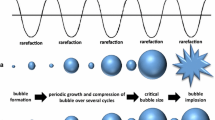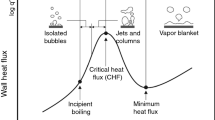Abstract
A mechanism of bubble formation in the escape of gas through a single opening into a liquid layer is proposed. A system of equations is obtained enabling one to determine the separation diameter of a bubble with allowance for the preoccluded volume.
Similar content being viewed by others
Literature cited
G. Kling, “Dynamics of bubble formation in fluids by gas injection under pressure,” Int. J. Heat Mass Transfer,5, 211–223 (1962).
V. I. Berdnikov, “Method of modeling bubble formation at a submerged opening,” Teor. Osn. Khim. Tekhnol.,15, No. 5, 772–775 (1981).
R. R. Hughes, A. E. Handlos, H. D. Evans, and R. L. Maycock, “The formation of bubbles at simple orifices,” Chem. Eng. Prog.,51, No. 12, 557–563 (1955).
L. Davidson and E. H. Amisk, “Formation of gas bubbles at horizontal orifices,” AIChE J.,2, 337–342 (1956).
A. A. Voloshko, A. V. Vurgaft, and V. I. Frolov, “Regimes of formation of gas bubbles in a liquid layer,” Inzh.-Fiz. Zh.,35, No. 6, 1066–1071 (1978).
J. F. Davidson and D. Harrison, Fluidization of Solid Particles [Russian translation], Khimiya, Moscow (1985).
S. C. Chuang and V. W. Goldschmidt, “Bubble formation due to a submerged capillary tube in quiescent and coflowing streams,” Trans. ASME, J. Basic Eng.,92, No. 4, 705–711 (1970).
I. Z. Kopp, “Analysis of forces acting on a vapor bubble,” in: Hydrodynamics and Heat Exchange in Power Equipment [in Russian], Ural. Nauch. Tsentr Akad. Nauk SSSR, Sverdlovsk (1975), pp. 34–44.
Yu. L. Sorokin, L. L. Bachilo, L. N. Demidova, and O. I. Anisimova, “Critical velocity for a descending liquid stream to carry off vapor bubbles,” Energomashinostroenie, No. 3, 1–3 (1976).
S. S. Kutateladze and V. E. Nakoryakov, Heat and Mass Exchange and Waves in Gas-Liquid Systems [in Russian], Nauka, Novosibirsk (1984).
Yu. L. Sorokin, “Conditions of stability of certain regimes of motion of gas-liquid mixtures in vertical pipes,” Zh. Prikl. Mekh. Tekh. Fiz., No. 6, 160–165 (1966).
O. V. Toropov and Yu. L. Sorokin, “Critical velocity of gas or vapor in the openings of perforated bubbling sheets,” Tr. Tsentr. Kotloturb. Inst., No. 202, 38–47 (1983).
Yu. A. Buevich and V. V. Butkov, “Mechanism of bubble formation in the escape of gas into a liquid from a round opening,” Teor. Osn. Khim. Tekhnol.,5, No. 1, 74–82 (1971).
Author information
Authors and Affiliations
Additional information
Translated from Inzhenerno-Fizicheskii Zhurnal, Vol. 50, No. 4, pp. 554–561, April, 1986.
Rights and permissions
About this article
Cite this article
Toropov, O.V. Influence of the preoccluded volume of gas on the separation diameter of a bubble. Journal of Engineering Physics 50, 389–394 (1986). https://doi.org/10.1007/BF00871058
Received:
Issue Date:
DOI: https://doi.org/10.1007/BF00871058




